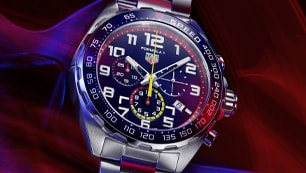


TAG HEUER 3000 SERIES
SUMMARY
The 3000 Series of dive watches and chronographs occupies an interesting position in the history of the TAG Heuer brand. Introduced in 1984, these watches mark the transition from Heuer to TAG Heuer, as well as the move from the classic chronographs of the 1960s and 1970s to the new styles of dive watches and chronographs that TAG Heuer would offer moving forward.
The 3000 Series celebrated the success of Heuer’s first two Series of dive watches – the 1000 Series and the 2000 Series – adding a premium positioning and a distinctive look. With the unique style of their cases and bezels, there is no mistaking the Series 3000 watches and chronographs for any timepieces that came before or after them, and these watches provide an interesting chapter in story of the dive watches that allowed TAG Heuer to survive the challenges that the Swiss watch industry faced in the 1970s and 1980s.
1984 marked a transitional period for Heuer, as the company stood between the 120-year period when it produced primarily mechanical chronographs and other timepieces for racing, and the new era in which it would survive difficult industry conditions by producing a wide variety of quartz powered dive watches and chronographs. Looking at Heuer’s 1984 catalog, we see the last of the Calibre 12-powered watches (such as the Autavia, Skipper, Monza and Calculator) along with the new Lemania 5100 watches (Carrera, Cortina and Silverstone). By 1984, Heuer had also achieved great success with its expansive range of diver watches - the 1000 Series and the 2000 Series. Seeking to capitalize on the success of these first collections of dive watches, in 1984 Heuer would introduce a new premium range of watches -- the 3000 Series.
While the 1000 and 2000 Series were extremely popular, lasting several decades, the 3000 Series remained in the TAG Heuer catalog for just over five years and underwent only minor changes throughout its life.
HEUER 3000
The 3000 Series design is essentially a development of the successful 2000 Series launched in 1982. Where the 2000 Series had a smooth, rounded case, the 3000 Series squared those curves away to create a more technical looking watch. Complementing the angular case was a prominent 12-sided bezel that sat inside the width of the watch. While not as wide as the case itself, the bezel was relatively thick. The bezel of the 3000 Series watches and chronographs also features small ball-shaped grips at each corner to make it easier to turn.
The pushers used on the 3000 Series chronographs are different from both the 1000 and 2000 Series, and have a similar design to the ones used on Heuer’s classic Calibre 12 chronographs from the 1970s.
The 3000 Series incorporated small design detail to give a premium feeling over the other dive watches in the Heuer range. Metal borders were used on each of the hour-markers, as well as on the date window and the sub-dials of the chronograph. Efforts were also made with the bracelet, several models having polished center links to contrast with the brushed finish of the outer-links.
The watch was initially available as a time-only watch and a chronograph in the four colours shown below and in four sizes -- as with the 1000 and 2000 Series, there were full size, medium, boy’s and lady’s models.
The chronograph shared the same basic design of the watch, the most significant design difference being the use of baguette-shaped hour-markers instead of the circles used on the time-only watch.
MOVEMENTS
The 3000 Series of watches used the same family of movements as the 2000 Series, with the majority of the watch range using the relatively common ESA 555.112/ ETA 955.112 quartz movement. The chronograph movements, however, are far more interesting because both the quartz and automatic chronograph use the Dubois Depraz 2000 chronograph module. The automatic movement (LWO 283) mates the DD2000 module to the ETA 2892 base while the quartz movement (Calibre 185) uses the same quartz base as the watch.
TAG HEUER 3000
With Heuer being acquired by Techniques d’Avant Garde in 1985, the 3000 Series carried on largely unchanged as a TAG Heuer. Apart from the obvious logo, the only change to the dial was the “3000” script moving from just below the Heuer shield to the bottom half of the dial.
Somewhere between 1986 and 1989 TAG Heuer stopped producing the 3000 Series chronograph, leaving only the basic watch in the catalog. This was around the time that TAG Heuer was phasing out its use of the Dubois Depraz movements.
There was one detailed change to the 3000 Series watch for its last year in 1989/1990. The very last of the series dropped the 3000 name from the dial entirely and replaced the monochrome TAG Heuer logo with a colored logo








